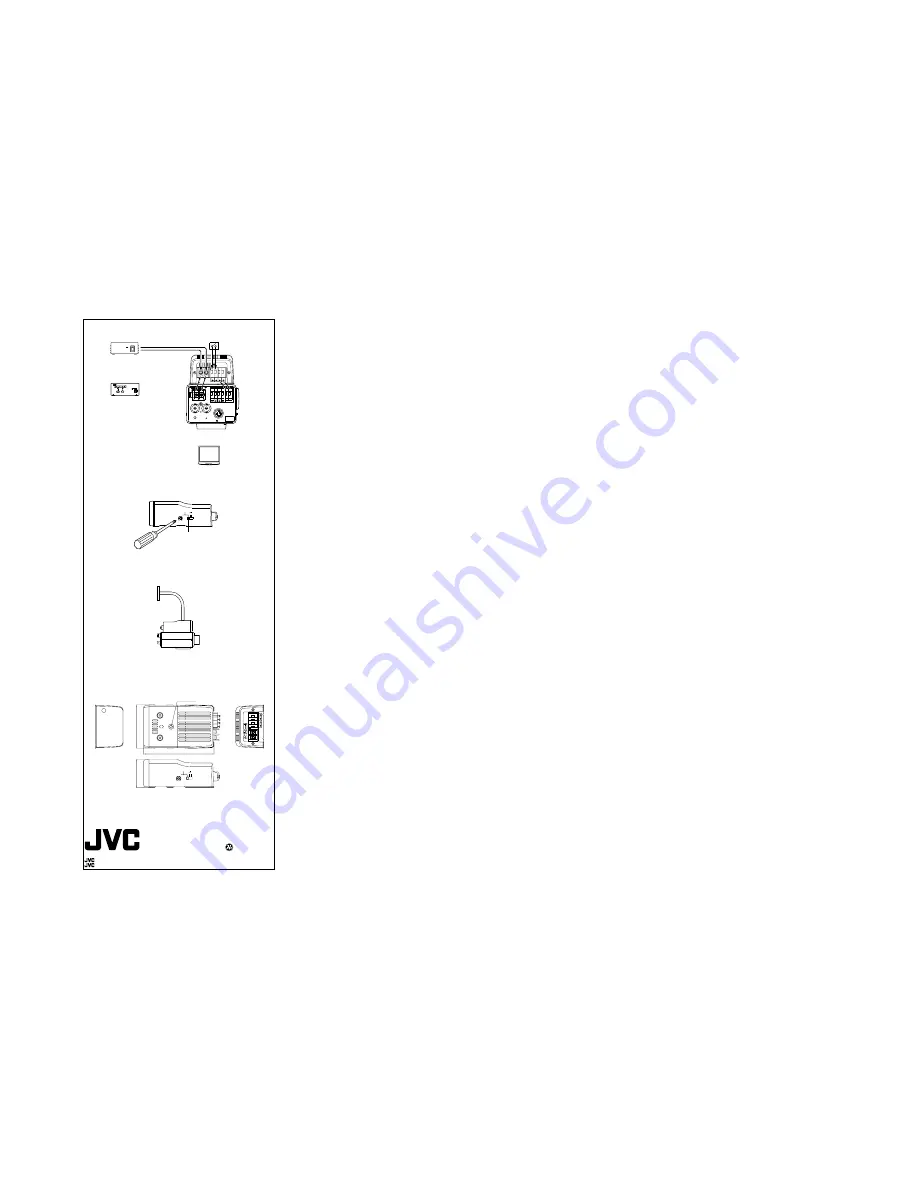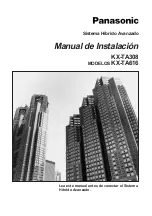
Setup for the KA-R60
1.
AUTO/MANUAL illumination mode switch selection
Set the AUTO/MANUAL illumination mode switch to the desired mode.
AUTO
: This unit starts and stops the IR light automatically according to the
surrounding brightness.
MANUAL ON
: The unit is always illuminated.
MANUAL OFF : The unit is not illuminated.
Note
When an external control signal is input to the EXT terminal of the KA-R60, the IR light will be
illuminated regardless of the setting of the illumination mode selection.
2.
SENS control
Adjusts the detection level of the surrounding brightness at the point that the illumination mode
switches ON or OFF automatically.
• The potentiometer has been set to start illuminating the IR light at about 2 lx.
Adjust the SENS control by turning the potentiometer counterclockwise to illuminate the IR
light at a lower surrounding brightness or clockwise to illuminate it at a higher surrounding
brightness.
• Cover the illumination sensor with a black cloth, etc. and make sure that the images are
switched from color to B&W when the unit begins to illuminate.
<Example of SENSE control adjustment>
While looking at an image, adjust the ND filter at the front of the camera lens. ND filters may be
adjusted as required until the monitor screen brightness attains the requisite level and the KA-
R60 starts to illuminate.
Place all of the ND filters that are set in front of the lens at the front of the illumination sensor
and then adjust the sensor control of the KA-R60 to illuminate the IR light with reference to this
condition.
Installation on a ceiling or wall
• When installing this unit on a wall or ceiling, attach the fixing bracket to the “camera mount
screw hole” on the top of the unit.
• For the attachment method of the fixing bracket and the camera drop-prevention wire, please
refer to the relevant instruction manual for the camera.
In case of problems…
1. The unit does not start to illuminate even though the AUTO/MANUAL illumination mode switch
is set to MANUAL ON.
A
Check if the power supply to the KA-R60 is connected properly.
2. The unit is not illuminated if the AUTO/MANUAL illumination mode switch is set to AUTO.
A
Adjust the SENS control potentiometer.
3. The unit is illuminated but the camera images are not switched to B&W.
A
• Check the connection between the IR-C terminal of the unit and the Aux control input of
the camera.
• Open the “B&W COLOR MODE” menu on the camera and check that the setting for
B&W is set to “AUX”.
• Set the AUTO/MANUAL illumination mode switch either to MANUAL ON or MANUAL OFF,
and confirm that the camera images are switched between B&W and Color accordingly.
䡵
CAUTION
When the camera is installed near a nightlight, the light may enter the illumination sensor of the
unit causing it to sense brightness and thus prevent normal illumination. In this case, change the
position of the camera or the shooting object relative to the position of the nightlight.
Specifications
Applicable camera
: TK-C1460, TK-C1460B
Peak wavelength
: 880 nm
Illumination range
: Approx. 10 meters long.
Area: Width 6 meters, height 4 meters.
External control input
: Grounded input
IR-CTL output
: Illumination ON (Grounded output)
Illumination OFF (High impedance)
Ambient temperature
: -10°C to 50°C (Specified)
0°C to 40°C (Recommended)
Power supply
: 24 V AC or 12 V DC, 50 Hz/60 Hz
Current consumption
: 150 mA (Illumination ON)
Weight
: Approx. 200
˝
Accessories
: Assembly screw
x 1
Camera mount screws
x 2
Instructions
x 1
Dimensions (Unit: mm)
(Design and specifications are subject to change without notice.)
LWT0099
©2002 VICTOR COMPANY OF JAPAN, LIMITED
®
is a Registered Trademark owned by VICTOR COMPANY OF JAPAN, LTD.
®
is a Registrated Trademark in Japan,the U.S.A., the U.K. and many other countries.
®
D
F
E
[: mm]
VICTOR COMPANY OF JAPAN, LIMITED
SENS
AUTO MANUAL
OFF ON
L
H
1.
2.
SENS
AUTO MANUAL
OFF ON
L
H
12
AC
24V
DC 12V
EXT
EXT
IR-C
IR-C
CLASS 2 ONL
Y For USA
ISOLA
TED PO
WER ONL
Y
For EUR
OPE
1/4-20 UNC
62
40
100
∆
D
∆
E
∆
F
C
1
2
AC 24V
DC 12V
EXT EXT IR-C IR-C
CLASS 2 ONLY For USA
ISOLATED POWER ONLY
For EUROPE
I
O
POWER
OFF
IN
OFF
OUTPUT3
OUTPUT2
IN
OUTPUT1
TK-A241 POWER SUPPLY UNIT
POWER
AC ADAPTOR AA-P70
(12 V DC)
24 V AC or 12 V DC
24 V AC oder 12 V DC
24 V CA ou 12 V CC
(24 V AC)
AA-P700
TK-A241
TK-C1460
EXT.
ON/OFF SW
Monitor (optional)
Monitor (optionales)
Moniteur (option)
VIDEO
INPUT
Or
Oder
Ou
DC12V
A
C24V
Y/C OUT
SYNC IN
POWER
VIDEO OUT
SEE INST-
RUCTION
MANUAL
+
-
1
2
CLASS 2 ONL
Y(U
TYPE)
ISOLA
TED PO
WER ONL
Y
(E
TYPE)
TX
+
TX
-
RX
+
RX
-
AUX GND
A
B
C
D
Einstellungen an KA-R60
1.
AUTO/MANUAL Wahl des Aktivierungsmodus
Stellen Sie den AUTO/MANUAL-Schalter auf die gewünschte Position.
AUTO
: Die Lampe wird automatisch, in Abhängigkeit von der Umgebungshelligkeit,
ein- und ausgeschaltet.
MANUAL ON
: Die Lampe ist stets eingeschaltet.
MANUAL OFF : Die Lampe ist ausgeschaltet.
Hinweis
Liegt am EXT-Eingang von KA-R60 ein externes Steuersignal an, erfolgt die Ein- und
Ausschaltung der Infrarotlampe unabhängig von der Einstellung des Aktivierungsmodus-
Schalters.
2.
SENS-Potentiometer
Dient zur Einstellung des Helligkeitsansprechpegels (Umgebungshelligkeit), bei dem die Lampe
aktiviert/deaktiviert wird.
• Ab Werk ist der Ansprechpegel auf ca. 2 Lux eingestellt.
Den Potentiometer gegen den Uhrzeigersinn/im Uhrzeigersinn drehen, wenn die Infrarotlampe
bei geringerer Umgebungshelligkeit/bei höherer Umgebungshelligkeit aktiviert werden soll.
• l Den Lichtsensor mit einem schwarzen Tuch etc. abdecken und überprüfen, ob das Bildsignal
bei Erreichen des Ansprechpegels (bei dem die Lampe aktiviert wird) vom Farb- auf den
Schwarzweißmodus wechselt.
<Einstellungsbeispiel für SENSE-Potentiometer>
Das Kamerasignal überwachen und dann das ND-Filter am Kameraobjektiv anbringen. ND-
Filter beeinflussen den Helligkeitspegel für das auf dem Monitorbildschirm angezeigte
Kamerasignal. Dies muss bei der Einstellung des Ansprechpegels von KA-R60 berücksichtigt
werden.
Die für das Kameraobjektiv vorgesehenen ND-Filter vor den Lichtsensor halten und dann den
Ansprechpegel von KA-R60 einstellen, so dass dieser auf den für das Kameraobjektiv geltenden
Helligkeitspegel abgestimmt ist.
Anbringen an einer Wand oder Decke
• Wenn diese Einheit an einer Wand oder Decke befestigt werden soll, muss die Kamerahalterung
am Gewinde für Kamerabefestigungsschraube, das sich an der Oberseite der Einheit befindet,
angebracht werden.
• Angaben zum Anbringen der Halterung oder des Sicherungsdrahtes finden Sie in der zur Kamera
gehörigen Bedienungsanleitung.
Bei Betriebsstörungen…
1. Die Lampe arbeitet nicht, obwohl der AUTO/MANUAL-Schalter auf MANUAL ON gestellt ist:
A
Überprüfen, ob die Stromquelle einwandfrei an KA-R60 angeschlossen ist.
2. Die Lampe arbeitet nicht, obwohl der AUTO/MANUAL-Schalter auf AUTO gestellt ist.
A
Mit dem SENS-Potentiometer den Ansprechpegel variieren.
3. Die Lampe ist aktiviert, die Kamerabilder werden jedoch nicht als Schwarzweißsignal abgegeben.
A
• Die Anschlussverbindung zwischen IR-C an dieser Einheit und dem AUX-Steuereingang
der Kamera überprüfen.
• Das Kameramenü “B&W COLOR MODE” öffnen und überprüfen, ob für B&W der
Einstellstatus “AUX” gilt.
• Den AUTO/MANUAL-Schalter entweder auf MANUAL ON oder MANUAL OFF stellen und
überprüfen, ob das Kamerasignal entsprechend zwischen dem Farb- und
Schwarzweißmodus wechselt.
䡵
VORSICHT
Wenn die Kamera so installiert wird, dass das von einer Nachtbeleuchtung ausgehende Licht auf
den Lichtsensor der Einheit einwirken kann, wird die normale Funktion der Lampe ggf. be- oder
verhindert. In diesem Fall die Position der Nachtbeleuchtung, der Kamera oder des zu
überwachenden Objekts ändern.
Technische Daten
Geeignete Kamera
: TK-C1460, TK-C1460B
Spitzenwellenlänge
: 880 nm
Ausleuchtungsbereich
: Ca. 10 Meter weit.
Fläche: Breite 6 Meter, Höhe 4 Meter.
Externes Steuersignal
: Eingang an Masse
IR CTL-Ausgang
: Lampe ein (ON) (Ausgang an Masse),
Lampe aus (OFF) (hohe Impedanz)
Umgebungstemperatur
: -10°C to 50°C (ausgewiesen),
0°C to 40°C (empfohlen)
Stromversorgung
: 24 V Wechselstrom oder 12 V Gleichstrom, 50 Hz/60 Hz
Leistungsaufnahme
: 150 mA (Lampe ein (ON))
Gewicht
: Ca. 200
˝
Zubehör
: Kameramontageschraube
x 1
Kamerabefestigungsschraube x 2
Anleitung
x 1
ABMESSUNGEN (Einheit: mm)
(Änderungen von Entwurf und technischen Daten bleiben jederzeit vorbehalten.)
∆
D
∆
E
∆
F
Réglage pour le KA-R60
1.
Réglage du sélecteur de mode d'illumination AUTO/MANUAL
Régler le sélecteur de mode d'illumination AUTO/MANUAL selon le mode souhaité.
AUTO
: L'appareil émet et arrête automatiquement la lumière IR selon la luminosité
ambiante.
MANUAL ON
: L'appareil est toujours illuminé.
MANUAL OFF : L'appareil n'est pas illuminé.
Remarque
Quand un signal de contrôle extérieur est entré à la borne EXT du KA-R60, la lumière IR est
émise indépendamment du réglage de sélection du mode d'illumination.
2.
Commande SENS
Ajuste le niveau de détection de la luminosité ambiante au point où le mode d'illumination
commute automatiquement à ON ou OFF.
• Le potentiomètre est réglé pour démarrer l'émission de la lumière IR à environ 2 lux.
Ajuster la commande SENS en tournant le potentiomètre dans le sens contraire des aiguilles
d'une montre pour émettre la lumière IR à luminosité ambiante faible, ou dans le sens des
aiguilles d'une montre pour l'émettre à une luminosité ambiante plus élevée.
• Couvrir le capteur d'illumination avec un tissu noir etc. et vérifier que les images sont commutés
de la couleur à B&W quand l'appareil commence à illuminer.
<Exemple d'ajustement de la commande SENS>
En regardant une image, ajuster le filtre ND à l'avant de l'objectif de la caméra. Des filtres ND
peuvent être ajustés comme requis jusqu'à ce que la luminosité de l'écran du moniteur atteigne
le niveau requis et que le KA-R60 commence à illuminer.
Placer tous les filtres ND montés à l'avant de l'objectif sur l'avant du capteur d'illumination,
puis ajuster la commande de capteur du KA-R60 pour émettre une lumière IR en référence à
cette situation.
Installation sur un plafond ou un mur
• A l'installation de cet appareil sur un mur ou un plafond, fixer l'étrier de fixation au "trou à vis de
montage sur caméra" sur le dessus de l'appareil.
• Pour la méthode de fixation de l'étrier de fixation et du fil antichute de la caméra, consulter le
mode d'emploi de la caméra concernée.
En cas de problème …
1. L'appareil ne commence pas à illuminer bien que le commutateur d'illumination AUTO/MANUAL
soit réglé à MANUAL ON.
A
Vérifier si l'alimentation du KA-R60 est connectée correctement.
2. L'appareil n'est pas illuminé si le commutateur d'illumination AUTO/MANUAL est réglé à AUTO.
A
Ajuster le potentiomètre de la commande SENS.
3. L'appareil est illuminé quand la caméra n'est pas commutée à B&W.
A
• Vérifier la connexion entre la borne IR-C de l'appareil et l'entrée de contrôle AUX de la
caméra.
• Ouvrir le menu "B&W/COLOR MODE" sur la caméra et vérifier que le réglage pour B&W
est "AUX".
• Régler le commutateur de mode d'illumination AUTO/MANUAL à MANUAL ON ou MANUAL
OFF, et confirmer que les images de la caméra sont commutées entre B&W et Color en
conséquence.
䡵
ATTENTION
Quand la caméra est installée près d'un éclairage de nuit, la lumière peut entrer dans le capteur
d'illumination de l'appareil provoquant une détection de luminosité et empêchant ainsi l'illumination
normale. Dans ce cas, changer la position de la caméra ou de l'objet à prendre par rapport à la
position de l'éclairage de nuit.
Spécifications
Caméra applicable
: TK-C1460, TK-C1460B
Longueur d'onde de crête
: 880 nm
Portée d'illumination
: Env. 10 m de longueur
Surface: largeur 6 mètres, hauteur 4 mètres
Entrée de commande extérieure
: Entrée mise à la terre
Sortie IR-CTL
: Illumination ON (sortie mise à la terre)
Illumination OFF (haute impédance)
Température ambiante
: -10 à +50˚C (spécifiée)
0 à 40˚C (recommandée)
Alimentation
: 24 V CA ou 12 V CC, 50 Hz/60 Hz
Consommation
: 150 mA (Illumination ON)
Poids
: Env. 200
˝
Accessoires
: Vis d'assemblage
x 1
Vis de montage sur caméra
x 2
Mode d'emploi
x 1
Dimensions (Unité: mm)
(Conception et spécifications sujettes à modification sans préavis.)
∆
D
∆
E
∆
F




















